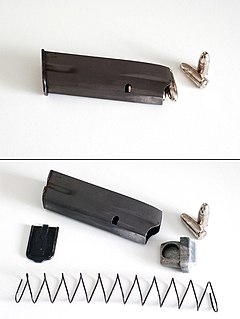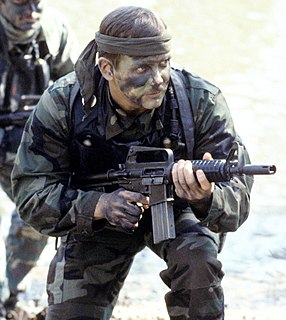
The Colt AR-15 is a lightweight, magazine-fed, gas-operated semi-automatic rifle. It is a semi-automatic version of the M16 rifle sold for the civilian and law enforcement markets in the United States. Colt's Manufacturing Company currently owns the AR-15 trademark and is used exclusively for its line of semi-automatic AR-15 rifles.

The Lee–Enfield is a bolt-action, magazine-fed repeating rifle that served as the main firearm of the military forces of the British Empire and Commonwealth during the first half of the 20th century, and was the British Army's standard rifle from its official adoption in 1895 until 1957. The WWI versions are often referred to as the "SMLE", which is short for the common "Short, Magazine, Lee–Enfield" variant.

A magazine is an ammunition storage and feeding device for a repeating firearm, either integral within the gun or externally attached. The magazine functions by holding several cartridges within itself and sequentially pushing each one into a position where it may be readily loaded into the barrel chamber by the firearm's moving action. The detachable magazine is sometimes colloquially referred to as a "clip", although this is technically inaccurate since a clip is actually an accessory device used to help load ammunition into a magazine.

The Colt Automatic Rifle-15 or CAR-15 is a family of M16 rifle–based firearms marketed by Colt in the 1960s and early 1970s. However, the term "CAR-15" is most commonly associated with the Colt Commando(AKA: XM177); these select-fire carbines have ultrashort 10.5-inch (270 mm) and 11.5-inch (290 mm) barrels with over-sized flash suppressors.

The .410 bore is one of the smallest caliber of shotgun shell commonly available. A .410 bore shotgun loaded with shot shells is well suited for small game hunting and pest control. The .410 started off in the UK as a garden gun along with the .360 and the No. 3 bore (9mm) rimfire, No. 2 bore (7mm) rimfire, and No. 1 bore (6mm) rimfire. .410 shells have similar base dimensions to the .45 Colt cartridge, allowing many single-shot firearms, as well as some derringers chambered in that caliber, to fire .410 shot shells without any modifications.

The .22 Hornet or 5.6×35mmR is a varminting, small-game hunting, survival and competition centerfire rifle cartridge commercially introduced in 1930. It is considerably more powerful than the rimfire .22 WMR and the .17 HMR, achieving higher velocity with a bullet twice the weight of the .17 HMR bullet. The Hornet also differs very significantly from these in that being a centerfire cartridge makes it reloadable, and thus much more versatile. It was the smallest commercially available .22 caliber centerfire cartridge until the introduction of the FN 5.7×28mm.

The Stoner 63 is a 5.56×45mm NATO modular weapon system. Using a variety of modular components, it can be configured as an assault rifle, carbine, top-fed light machine gun, belt-fed squad automatic weapon, or as a vehicle mounted weapon. Also known as the M63, XM22, XM23, XM207 or the Mk 23 Mod 0 machine gun, it was designed by Eugene Stoner in the early 1960s. Cadillac Gage was the primary manufacturer of the Stoner 63 during its history. The Stoner 63 saw very limited combat use by United States forces during the Vietnam War. A few were also sold to law enforcement agencies.

The SR-25 is a designated marksman rifle and semi automatic sniper rifle designed by Eugene Stoner and manufactured by Knight's Armament Company.
The Colt Automatic Rifle or Colt Light Machine Gun is a 5.56 mm NATO, open-bolt, full-automatic-only firearm developed by Colt Defense. It is based on the M16A2/A4, and has a distinctive squared-off handguard, vertical grip, carrying handle and integrated bipod.

The ArmaLite AR-7 Explorer is a semi-automatic firearm in .22 Long Rifle caliber, developed in 1959 from the AR-5 that was adopted by the U.S. Air Force as a pilot and aircrew survival weapon. The AR-7 was adopted and modified by the Israeli Air Force as an aircrew survival weapon in the 1980s.
The Heckler & KochG41 is a German 5.56×45mm NATO assault rifle introduced in 1981 and produced in limited quantities by Heckler & Koch. It was designed to replace the 7.62×51mm NATO chambered Heckler & Koch G3 and the G3 based .223 Remington/5.56×45mm and later 5.56×45mm NATO chambered Heckler & Koch HK33 service rifles providing a more modern weapon compatible with then recently introduced NATO standards. It can use both the then new STANAG 4172 compliant 5.56×45mm NATO SS109, SS110, and SS111 ammunition and older .223 Remington/5.56×45mm M193 ammunition and was the last Heckler & Koch service rifle designed around the roller-delayed blowback mechanism.
The ArmaLite AR-5 is a lightweight bolt-action takedown rifle chambered for the .22 Hornet cartridge and adopted as the MA-1 aircrew survival rifle by the United States Air Force. It was developed by ArmaLite, a division of Fairchild Engine and Airplane Corporation in 1954.

The M6 Aircrew Survival Weapon was a specially-made .22 Hornet over .410 bore combination gun issued to United States Air Force aircrews to help forage for food in the event of a plane crash. It was issued from 1952 until the early 1970s, in conjunction with the M4 Survival Rifle. Plans to replace both with the ArmaLite AR-5 never came to fruition and in 2018 was instead replaced with the GAU-5A Aircrew Self Defense Weapon in some instances.

The Springfield Armory M6 Scout is a .22 Hornet over .410 bore combination gun that is virtually identical to the original M6 Aircrew Survival Weapon. It is also made in .22 Long Rifle over .410 bore and .22 Magnum over .410 bore. The Scouts are made with 18.25 inches (46.4 cm) barrels, as opposed to the original M6's 14 inches (36 cm) barrel length, to comply with National Firearms Act. The later models have large over-sized trigger guards and Picatinny rails for mounting a wide range of sights and scopes. They come in stainless steel or with a Parkerized finish.

The T91 rifle is produced by the 205th Armory of National Defense in Republic of China. It is based on the proven T86 assault rifle, incorporating features from the M16 and AR-18 rifles with more modern features. The T91 is lighter and shorter than the T65 it replaces and has a 3-position telescoping stock to allow adjustment based on individual requirements.

The M30 Luftwaffe drilling ("triple") was a survival weapon issued to Luftwaffe pilots during World War II. It was primarily issued to airmen operating in North Africa. The M30 was intended to be used for hunting and self-defense against natural predators.
The Roberti–Roos Assault Weapons Control Act of 1989 (AWCA) is a California law that bans the ownership and transfer of over 50 specific brands and models of semi-automatic firearms, which were classified as assault weapons. Most were rifles, but some were pistols and shotguns. The law was amended in 1999 to restrict acquisition and transfer of magazines that could hold more than 10 rounds of ammunition. Firearms and magazines that were legally owned at the time the law was passed were grandfathered if they were registered with the California Department of Justice. The law was overturned in June 2021 in Miller v. Bonta; the ruling is stayed pending appeal.

The Adaptive Combat Rifle (ACR) is a modular assault rifle designed by Magpul Industries of Austin, Texas, and known initially as the Masada.

Lewis Machine and Tool Company (LMT) is an American armaments company. It was founded by Karl Lewis in 1980. LMT started its business by providing US law enforcement and government agencies with military type weapons and accessories. Subsequently, they expanded to supply military and commercial retailers. All of LMT's engineering and manufacturing is done at their facility in Eldridge, Iowa. LMT manufactures complete weapon systems such as the M4 and the M203. The militaries of the United Kingdom, New Zealand, Estonia and the United States use LMT products.

An AR-15 style rifle is any lightweight semi-automatic rifle based on the Colt AR-15 design.
















